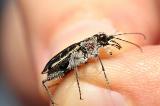
New York Wildlife Action Plan
By the Association of Fish and Wildlife Agencies
New York’s Department of Environmental Conservation (DEC) seeks to use its Wildlife Action Plan to enhance the state’s efforts to conserve species that improve the lives of New York residents and visitors.
Planners used the state’s major watersheds to organize the strategy, both to instill a sense of place to users of the document and to build on the state’s successful watershed programs. Many of these watershed programs have been running successfully for over 30 years.
New York’s Wildlife Action Plan offers an opportunity to integrate and strengthen those programs that are primarily driven by water chemistry with goals for fish and wildlife.
Management
Our forests, streams, lakes and ocean have provided bounty first to our tribal nations, then to European settlers. We are now a state of over 19 million residents, 20 percent of whom are foreign born. Our cultural and natural diversity mirror each other and deserve to be celebrated. The population density of our residents ranges from over 300,000 people per square mile to less than 1 person per square mile. In the 400 years of European settlement in our state, there have been changes to our landscape from dense primeval forest to abundant farmland, and now the return of crop lands to forest between our large cities. Every part of the state contains special natural beauty from the wilderness of our forest preserves to the refuges of our stunning urban parks.
Wildlife Highlights
We host an amazing variety of wildlife from the huge Atlantic right whale to the tiniest salamanders, and animals of all sizes in between. New York is home to the only known population of Chittenango ovate amber snail in the world. There are more dragonfly and damselfly species in New York than any state but Texas, and more mammal species than any state in the Northeast. However, only 55% of the state’s plants and vertebrates are considered secure and the status of most invertebrate species remains unknown.
Primary Challenges to Conserving Wildlife in New York
Statewide, the top three threats identified were habitat loss and fragmentation, various types of water and air pollution, and invasive species. Poorly planned development that includes road building and sprawling retail and residential development moving into formerly rural and wild areas has a severe impact on most of the vulnerable species in the state. In areas of central and western New York, this increase in developed land is occurring at nearly ten times the population growth rate. The results include a drain on community services and real destruction of the natural resources in the area, without economic or social benefit to the surrounding communities.
Working Together for New York’s Wildlife
The DEC invited participation from a wide array of stakeholders from the beginning of the planning process. Many scientists and non-governmental organizations participated in the selection of the species of greatest conservation need.
A State Wildlife Grants Partnership, consisting of 70 agency representatives, tribal nations, sportsmen’s groups and other conservation organizations, was established to assist in developing the Wildlife Action Plan. Many of these stakeholders reviewed and revised sections of the Plan as they were drafted. The entire draft of the Plan was released for public review prior to submittal to the US Fish and Wildlife Service.
The Association of Fish and Wildlife Agencies represents all of North America’s fish and wildlife agencies, promotes sound management and conservation, and speaks with a unified voice on important fish and wildlife issues.





